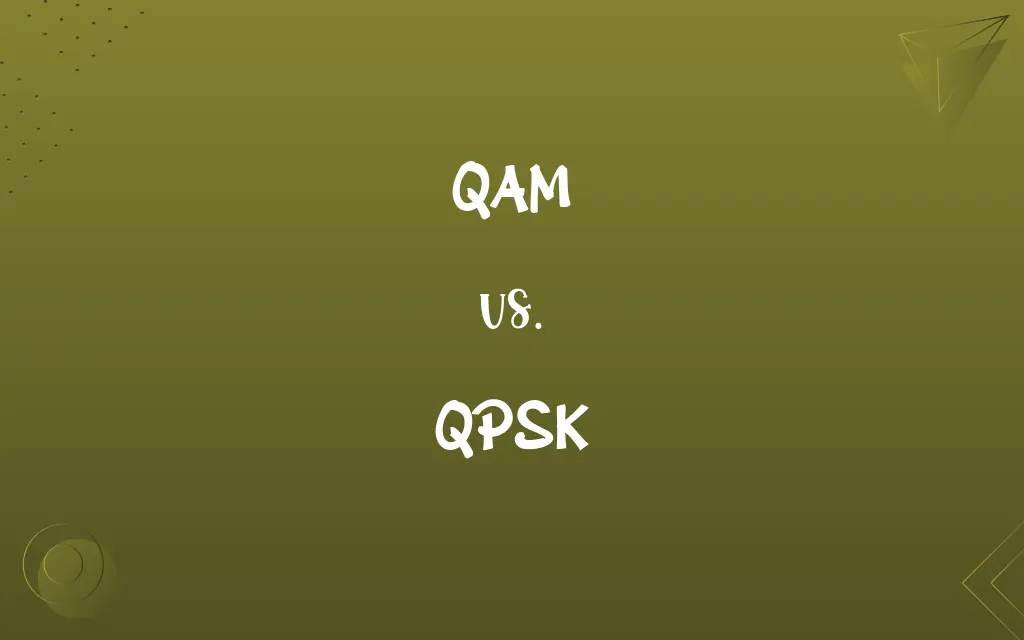QAM vs. QPSK: Know the Difference

By Shumaila Saeed || Published on February 3, 2024
QAM (Quadrature Amplitude Modulation) varies both phase and amplitude, while QPSK (Quadrature Phase Shift Keying) changes only phase with a constant amplitude.

Key Differences
QAM, or Quadrature Amplitude Modulation, is a modulation technique that modifies both amplitude and phase of the carrier signal. QPSK, or Quadrature Phase Shift Keying, on the other hand, only alters the phase of the carrier signal. While both are used in digital transmission, QAM's dual modulation allows more data to be transmitted.
Shumaila Saeed
Feb 03, 2024
In QAM, the combination of amplitude and phase change increases the number of possible signal combinations, allowing for higher bit rates. QPSK, with its phase-only modulation, has fewer combinations but is simpler and more robust against noise. QAM's complexity can lead to higher error rates under poor transmission conditions compared to QPSK.
Shumaila Saeed
Feb 03, 2024
QAM is highly efficient in bandwidth utilization but more susceptible to noise and distortions. In contrast, QPSK, though less efficient in bandwidth, offers greater robustness in noisy environments. This makes QAM more suitable for cable and broadband applications, whereas QPSK is often preferred in satellite and radio communications.
Shumaila Saeed
Feb 03, 2024
The implementation of QAM is more complex and costly due to its intricate signal constellation. QPSK, being simpler, requires less sophisticated and hence less expensive equipment. This cost and complexity difference makes QAM more suited for high-capacity networks, while QPSK is often used in cost-sensitive applications.
Shumaila Saeed
Feb 03, 2024
Finally, in terms of power efficiency, QAM, especially at higher levels like 64-QAM or 256-QAM, tends to be less power efficient than QPSK. QPSK, with its constant amplitude, maintains consistent power usage, making it more suitable for power-constrained applications like satellite communication.
Shumaila Saeed
Feb 03, 2024
ADVERTISEMENT
Comparison Chart
Modulation Technique
Modulates both amplitude and phase.
Modulates only phase.
Shumaila Saeed
Feb 03, 2024
Signal Combinations
More signal combinations available.
Fewer signal combinations.
Shumaila Saeed
Feb 03, 2024
Susceptibility to Noise
More susceptible to noise.
More robust against noise.
Shumaila Saeed
Feb 03, 2024
Power Efficiency
Less power efficient at higher levels.
More consistent power efficiency.
Shumaila Saeed
Feb 03, 2024
ADVERTISEMENT
QAM and QPSK Definitions
QAM
QAM is a modulation scheme combining amplitude and phase modulation.
In digital TV broadcasting, QAM is used for its ability to carry more data.
Shumaila Saeed
Jan 23, 2024
QPSK
QPSK offers a balance between data rate and signal robustness.
QPSK is preferred in RF communication for its resilience to signal degradation.
Shumaila Saeed
Jan 23, 2024
QAM
QAM encodes data into signal amplitude and phase changes.
High-level QAM is favored in cable modems for faster internet speeds.
Shumaila Saeed
Jan 23, 2024
QPSK
QPSK maintains constant amplitude, varying only the phase of the carrier wave.
GPS systems often utilize QPSK for reliable data transmission.
Shumaila Saeed
Jan 23, 2024
QAM
QAM achieves higher data rates by using a complex signal constellation.
Advanced wireless technologies often employ QAM for higher throughput.
Shumaila Saeed
Jan 23, 2024
ADVERTISEMENT
QPSK
QPSK transmits data by changing the carrier phase in four distinct states.
In QPSK, each phase shift represents two bits of digital data.
Shumaila Saeed
Jan 23, 2024
QAM
QAM allows more bits per symbol by varying both amplitude and phase.
64-QAM transmits more bits per symbol compared to simpler modulation schemes.
Shumaila Saeed
Jan 23, 2024
QPSK
QPSK is simpler than QAM, focusing on phase shifts for data encoding.
Due to its simplicity, QPSK is used in many low-cost digital radio applications.
Shumaila Saeed
Jan 23, 2024
QAM
QAM is a blend of amplitude and phase modulation to increase bandwidth efficiency.
QAM is essential in achieving the high data rate demands of modern communication systems.
Shumaila Saeed
Jan 23, 2024
QPSK
QPSK is a digital modulation scheme that alters signal phase in steps.
QPSK is widely used in satellite communication for its efficiency and simplicity.
Shumaila Saeed
Jan 23, 2024
Repeatedly Asked Queries
Where is QAM commonly used?
In cable television and broadband communication.
Shumaila Saeed
Feb 03, 2024
What are the advantages of QAM?
Higher data transmission rates and efficient bandwidth usage.
Shumaila Saeed
Feb 03, 2024
What is the key characteristic of QAM?
It varies both amplitude and phase of the carrier signal.
Shumaila Saeed
Feb 03, 2024
Is QPSK more robust than QAM?
Yes, especially in noisy or unreliable transmission environments.
Shumaila Saeed
Feb 03, 2024
What are the disadvantages of QAM?
Higher susceptibility to noise and signal distortion.
Shumaila Saeed
Feb 03, 2024
Is QAM more complex to implement than QPSK?
Yes, due to its amplitude and phase variation.
Shumaila Saeed
Feb 03, 2024
How does weather affect QAM and QPSK?
QAM is more affected by weather-related signal degradation than QPSK.
Shumaila Saeed
Feb 03, 2024
What is the main advantage of QPSK?
Better noise immunity and simpler implementation.
Shumaila Saeed
Feb 03, 2024
Which is more power-efficient, QAM or QPSK?
QPSK tends to be more power-efficient.
Shumaila Saeed
Feb 03, 2024
How does QPSK differ from QAM?
QPSK only changes the phase, not the amplitude.
Shumaila Saeed
Feb 03, 2024
Which is better for long-distance communication, QAM or QPSK?
QPSK, due to its robustness to signal degradation.
Shumaila Saeed
Feb 03, 2024
Can QPSK handle high-speed data transmission?
It can, but not as efficiently as higher-order QAM.
Shumaila Saeed
Feb 03, 2024
Are there different levels of QAM?
Yes, such as 16-QAM, 64-QAM, and higher.
Shumaila Saeed
Feb 03, 2024
Can QAM transmit more data than QPSK?
Yes, due to its more complex signal constellation.
Shumaila Saeed
Feb 03, 2024
Can QAM and QPSK be used together?
Yes, in some advanced communication systems.
Shumaila Saeed
Feb 03, 2024
Is QAM suitable for mobile communications?
Yes, especially in 4G and 5G networks.
Shumaila Saeed
Feb 03, 2024
Share this page
Link for your blog / website
HTML
Link to share via messenger
About Author
Written by
Shumaila SaeedShumaila Saeed, an expert content creator with 6 years of experience, specializes in distilling complex topics into easily digestible comparisons, shining a light on the nuances that both inform and educate readers with clarity and accuracy.








































































